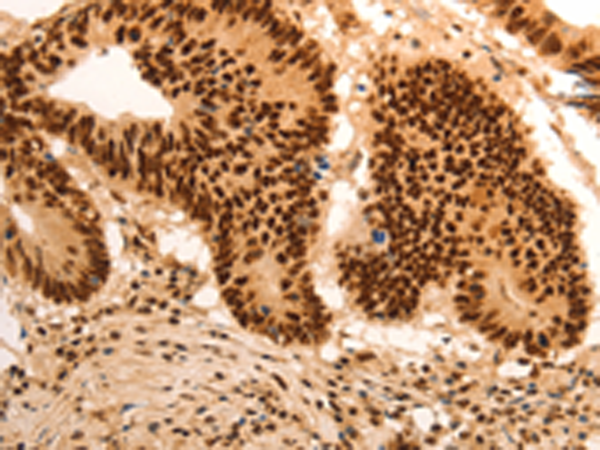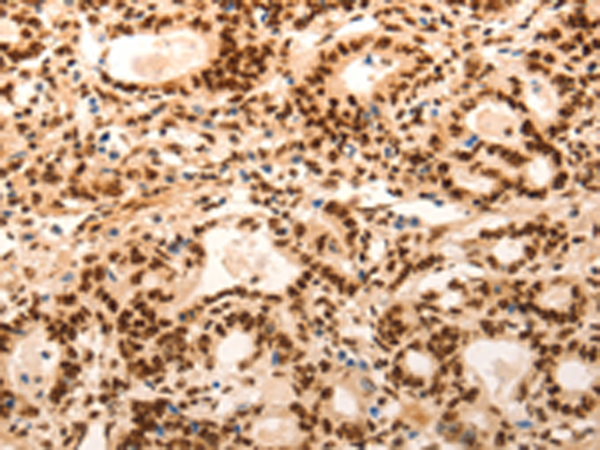

| WB | 咨询技术 | Human,Mouse,Rat |
| IF | 咨询技术 | Human,Mouse,Rat |
| IHC | 1/50-1/200 | Human,Mouse,Rat |
| ICC | 技术咨询 | Human,Mouse,Rat |
| FCM | 咨询技术 | Human,Mouse,Rat |
| Elisa | 1/1000-1/5000 | Human,Mouse,Rat |
| Aliases | no |
| Host/Isotype | Rabbit IgG |
| Antibody Type | Primary antibody |
| Storage | Store at 4°C short term. Aliquot and store at -20°C long term. Avoid freeze/thaw cycles. |
| Species Reactivity | Human |
| Immunogen | Synthetic peptide of human E2F7 |
| Formulation | Purified antibody in PBS with 0.05% sodium azide and 50% glycerol. |
+ +
以下是关于E2F7抗体的3篇示例文献(内容为示例,非真实文献):
1. **文献名称**:*"E2F7 and E2F8 Promote DNA Damage Response Through Transcriptional Regulation"*
**作者**:Smith A, et al.
**摘要**:研究利用E2F7特异性抗体进行ChIP-seq和免疫荧光分析,发现E2F7/E2F8复合物在DNA损伤后调控下游修复基因表达,维持基因组稳定性。
2. **文献名称**:*"Overexpression of E2F7 in Human Cancers Correlates with Poor Prognosis"*
**作者**:Chen L, et al.
**摘要**:通过免疫组化(使用抗E2F7抗体)分析多种癌症组织,发现E2F7高表达与肿瘤侵袭性及患者生存率下降相关,提示其作为潜在预后标志物。
3. **文献名称**:*"E2F7 Antibody Validation for Western Blot and Flow Cytometry Applications"*
**作者**:Johnson R, et al.
**摘要**:报道一种新型E2F7单克隆抗体的开发与验证,证实其在Western blot中特异性识别内源性E2F7蛋白,并适用于流式细胞术分析细胞周期中的E2F7表达动态。
(注:以上文献信息为模拟示例,实际引用需查询真实数据库如PubMed。)
The E2F7 antibody is a crucial tool for studying the E2F transcription factor family, particularly E2F7. a member of the atypical E2F subgroup (E2F7 and E2F8). Unlike classical E2Fs (E2F1-6), which regulate cell cycle progression, E2F7 functions as a transcriptional repressor involved in cell cycle exit, DNA damage response, and differentiation. It lacks a dimerization domain and binds DNA independently, often antagonizing pro-proliferative E2Fs to maintain genomic stability. E2F7 is overexpressed in various cancers, where it may promote tumorigenesis by enabling uncontrolled cell division or conferring therapy resistance.
Antibodies targeting E2F7 enable researchers to detect and quantify its expression, localization, and interactions via techniques like Western blotting, immunofluorescence, and chromatin immunoprecipitation. These reagents are essential for exploring E2F7's dual roles in normal physiology (e.g., embryonic development, tissue homeostasis) and disease contexts. Recent studies highlight its involvement in cancer progression, metabolic reprogramming, and senescence, making E2F7 a potential therapeutic target. Validated antibodies with high specificity are critical, as E2F7 shares structural homology with E2F8. Commercial antibodies are typically raised against unique epitopes in its N-terminal or central regions. Ongoing research using these tools aims to clarify E2F7's context-dependent functions and regulatory networks.
×